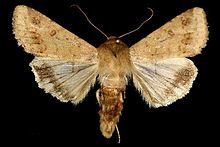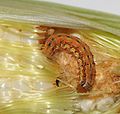- Helicoverpa zea
-
Helicoverpa zea 

Scientific classification Kingdom: Animalia Phylum: Arthropoda Class: Insecta Order: Lepidoptera Family: Noctuidae Genus: Helicoverpa Species: H. zea Binomial name Helicoverpa zea
(Boddie, 1850)Synonyms - Heliothis zea Boddie, 1850
- Heliothis umbrosus Grote, 1862
- Heliothis ochracea Cockerell, 1889
- Helicoverpa stombleri (Okumura & Bauer, 1969)
- Heliothis stombleri Okumura & Bauer, 1969
The larva of the moth Helicoverpa zea (formerly in the genus Heliothis) is a major agricultural pest. It can feed on many different plants (i.e. it is polyphagous) during the larval stage. Accordingly, the species has been given many different common names. When the larva consumes cotton, it is known as the cotton bollworm. When it consumes corn, it is known as the corn earworm. When it consumes tomatoes, it is known as the tomato fruitworm. It has also been known to consume many other crops. The adult moth is a pollinator and it is pictured on the right engaging in this process.
The larva (caterpillar) is very aggressive and will bite. It has been known to attack and consume other larvae of the same species.
The impact of this pest has been and continues to be significant, especially because of the wide range of crops attacked, and the natural abundance of the species in the wild.
Helicoverpa armigera, a close relative of H. zea from which the latter evolved, is a major pest in Asia, Africa and Australia.
The insidious flower bug (Orius insidiosus), a pirate bug, feeds on the eggs of H. zea, thus acting as a biological control agent. The braconid wasp Microplitis croceipes, which deposits its eggs inside a living caterpillar, is also an important parasitoid of both H. zea and the related species Heliothis virescens.[1]
Contents
Identification
Helicoverpa zea larvae are green, brown, or pinkish with darker longitudinal stripes; they grow to about 3.7 cm (1.5 inches) in length. Adults are most active during the evening and at night. An adult has a body length of approximately 1.9 cm (0.75 inches) and a wingspan of 2.5 to 3.8 cm (1 to 1.5 inches.[2] Its body is yellowish tan with distinctive double lines that are reddish brown, olive green or grey (Coxwell 1984, p. 141). The forewing has several dark marking and a central brown dot. The hindwings are pale in colour and surrounded by a dark brown border. It has a tan coloured head with bright green eyes. The male and female moths are very similar morphologically, which make it difficult to differentiate the two.[3]
Human Impact
The corn earworm is considered to be a major agricultural pest, with a large host range encompassing not only corn, but also numerous other crop plants.[4] Pesticides are one method by which corn earworm populations are controlled; however, since they have been widely used, the insects are resistant to many pesticides. The use of biological controls such as the bacterium Bacillus thuringiensis and various forms of nematodes is also common, although not without its own problems. Corn earworms are only variably vulnerable to the bacterium, and nematodes are only effective once the larvae have pupated and dropped to the ground.[5]
Natural history
Distribution
The corn earworm is found in temperate and tropical regions of the world.[6] It is mainly found in North America, but is not found in northern Canada and Alaska, as it cannot overwinter in these areas. Corn earworm regularly migrates into northern regions from southern regions depending on winter conditions.[7]
Life cycle
Eggs are individually deposited on leaf hairs and corn silks and hatch in about 3 to 4 days. Following hatching, larvae normally feed on the reproductive structures of the plant and usually develop through four to six instars.[8] Older larvae become aggressive and cannibalistic, resulting in one or two larvae per feeding site (Boyd 2008, p. 143). Mature larvae migrate to the soil, where they pupate for 12 to 16 days. Adult moths collect nectar or other plant exudates from a large number of plants, and live for 12 to 16 days. Females lay up to 2500 eggs in their lifetimes.[9]
Gallery
References
- ^ Tomberlin, Jeffery K; Moukaram Tertuliano, Glen Rains, W. Joe Lewis (September 2005). "Conditioned Microplitis croceipes Cresson (Hymenoptera: Braconidae) Detect and Respond to 2,4-DNT: Development of a Biological Sensor" (pdf). J. Forensic Sci. 50 (5). doi:10.1520/JFS2005014. http://forensicentomology.tamu.edu/pdf/JFS05014.pdf. Retrieved 21 February 2011.
- ^ http://www.ipm.ucdavis.edu/PMG/r113300911.html
- ^ http://www.omafra.gov.on.ca/english/crops/facts/95-065.htm
- ^ http://www.omafra.gov.on.ca/english/crops/facts/95-065.htm
- ^ http://edis.ifas.ufl.edu/IN302
- ^ http://www.extento.hawaii.edu/kbase/Crop/Type/helicove.htm#BIOLOGY
- ^ http://edis.ifas.ufl.edu/IN302
- ^ http://www.extento.hawaii.edu/kbase/Crop/Type/helicove.htm#BIOLOGY
- ^ http://www.extento.hawaii.edu/kbase/Crop/Type/helicove.htm#BIOLOGY
Literature
- Capinera, J.P. [1]. Corn Earworm, Helicoverpa (=Heliothis) zea (Boddie) (Lepidoptera: Noctuidae), 2008.
- Cooke, K.A., Weinzier, R. [2]IPM: Field Crops: Corn Earworm (Heliothis Zea), 2004.
- Coxwell, V.C. (1984) Eastern Moths. Peterson Field Guides. 141pp.
- Hagerman, P. [3], Corn Earworm Factsheet, 2008.
- Zimmerman, E.C. [4], Heliothis zea (Boddie), 1958.
- Boyd, B.M. (2008) Predaceous Behavior by Helicoverpa zea (Boddie) (Lepidoptera: Noctuidae: Heliothinae). Journal of Insect Behavior 21:143-46.
- Hill, D.S.[5], Heliothis zea (Boddie), 1983.
External links
- corn earworm on the UF / IFAS Featured Creatures Web site
- corn earworm moth Find large format diagnostic photos and information.
- J. L. Capinera, Corn Earworm, Helicoverpa (=Heliothis) zea (Boddie) (Lepidoptera: Noctuidae),
- A new synonym of Helicoverpa zea (Boddie) and differentiation of adult males of H. zea and H. armigera (Hübner) (Lepidoptera: Noctuidae: Heliothinae)
Categories:- Helicoverpa
- Agricultural pest insects
- Tomato pathogens and pests
- Animals described in 1850
Wikimedia Foundation. 2010.




